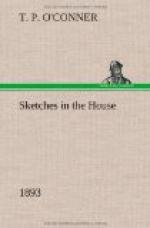[Sidenote: A pathetic scene.]
And then came the pathetic scene, in which again Mr. Bryce figured, and which once more brought out the marvellous grasp, the tenacious and inevitable memory of the splendid Old Man. The amendment of Lord Wolmer was, declared Mr. Gladstone, against “the law of Parliament,” and, by way of emphasizing this point, he wanted to have a quotation made from Sir Erskine May’s Book on Parliament. But the eyesight of age is weak, and there is in the House of Commons, until the gas is lit, something of the dim, religious light of a cathedral, and, accordingly, Mr. Gladstone had to rely on the younger eyes of Mr. Bryce. The scene which followed might be described as out of order, for there were two members standing at the same time. But the vast ascendancy of Mr. Gladstone over the assembly—the profound reverence in which all, save the meanest, bow before his genius, character, and age—enable him to do things not permitted to common men. In the rapt and serious face, in the attentive look, in the fingers beating the table as word followed word in confirmation of this view—in the curious, almost weird and unusual sight of two men standing side by side, Mr. Gladstone silent, Mr. Bryce speaking—there was a scene, the impressiveness, poetry, and pathos of which will never pass from the memory of those who saw it. And the House—so quick, with all its passion, and fractiousness, and meannesses, at grasping the significance of a great and solemn moment—marked its sense of the scene by a stillness that was almost audible—a hush that spoke aloud.
[Sidenote: And yet another.]




